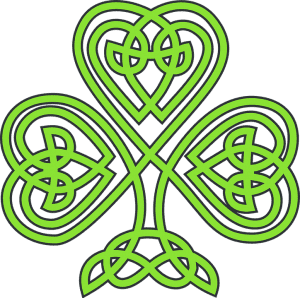Shamrocks, people dressed in green, foaming pints of stout being passed across numerous bars – these are the images that might leap into your mind at the mention of St Patrick’s Day.
But who was St Patrick, how did he come to be associated with such activities and how is his day celebrated around this modern globalised world? Below are a few facts about Ireland’s patron saint and the day dedicated to him:
St Patrick
St Patrick (who it is estimated lived between AD 385-461) was not Irish, but was born in Britain during the time of the Roman Empire.
Of mixed British and Roman descent, he was captured by Irish raiders and taken to Ireland as a slave. He escaped, but later returned as a missionary determined to convert the pagan Irish to the Christian religion.

As part of his missionary work, St Patrick is said to have expelled all the snakes from Ireland. There are no snakes in Ireland, but this is because Ireland became cut off from mainland Europe long before Britain did and before snakes had a chance to migrate there.
The snakes are, however, symbolic of Patrick casting paganism out of Ireland, as snakes often represent evil in Christian thought.
Patrick is also said to have used a three-leafed clover – or shamrock – to explain the Christian Trinity to the Irish. The clover, however, does not seem to have been associated with St Patrick or seen as a symbol of Irishness until the 1680s.
Three was, nevertheless, an important number to the Celts – their gods, like those of many other peoples, were often grouped in threes – so clovers may have been used in early missionary work.
St Patrick is said to have died on March 17th, which became his official feast day in the Catholic Church calendar.


Though St Patrick’s Day falls in Lent, it was exempt from the strict rules that restricted the consumption of alcohol and rich food in this period. This may have been the origin of the link between St Patrick’s Day and having a good time.
St Patrick’s Day is also celebrated by the Anglican, Eastern Orthodox and Lutheran Churches.
St Patrick’s Day Celebrations
As well as Church services, over the years St Patrick’s Day has involved parades, wearing shamrocks, wearing special St Patrick’s crosses (Celtic crosses made of paper and decorated with silk and ribbons), attending ceilithe (traditional Irish music sessions), enjoying dinners and banquets, and wearing green.
The colour green has been associated with Ireland since at least the 1640s and with St Patrick’s Day since the 1680s. (St Patrick was, however, sometimes associated with blue).
During the 1790s, green became linked with Irish Nationalism – due to its use by groups like the United Irishmen – and through the 19th century the connection between green, St Patrick’s Day and Irishness grew stronger.


One curious St Patrick’s Day custom is called ‘downing the shamrock’ or ‘wetting the shamrock’. This involves a shamrock being put at the bottom of a glass which is filled with whiskey, beer or cider. The liquid is drunk as a toast to St Patrick and Ireland and the shamrock is either swallowed or tossed over the shoulder for good luck.
St Patrick’s Day Goes Global
St Patrick’s Day is now celebrated internationally, with the festivities especially strong in countries where many people of Irish descent have settled, such as the UK, the USA and Canada.
The UK’s biggest St Patrick’s Day parade takes place in Birmingham, whose organisers claim it is the world’s third largest St Patrick’s Day procession after Dublin’s and New York’s.


In London, the water in Trafalgar Square’s fountains is sometimes dyed green, as is the water in one of the White House fountains each year. Even more spectacularly, a whole stretch of the Chicago River is turned green during that city’s St Patrick’s celebrations.
St Patrick’s Day is a public holiday in the Republic of Ireland, Northern Ireland, the Canadian province of Newfoundland and Labrador, and, curiously, on the small Caribbean island of Montserrat. This is because Monserrat was settled by Irish migrants from the islands of St Kitts and Nevis. March 17th also commemorates a slave uprising on Monserrat.
Sometimes celebrations in the Irish diaspora – there are estimated to be 70 million people of Irish descent around the world – have influenced how St Patrick’s Day is marked back in Ireland.
The first St Patrick’s Day parades were held in America and did not spread to Ireland until the 20th century, with the first one taking place in Waterford in 1903. Early parades would involve groups such as fire brigades, military personnel, voluntary and youth organisations, and trade unions. Over time, the parades have become much more like carnivals.


Not everybody, however, approves of St Patrick’s Day revelry. Some have criticised the festival for straying too far from its Christian roots and becoming little more than an excuse for drunkenness. Others have claimed the festivities have become over-commercialised and that – with their leprechaun costumes and inflatable shamrocks – they present a stereotypical ‘plastic paddy’ type view of Irish culture.


Today St Patrick’s Day celebrations have become truly globalised, spreading far beyond Ireland and the world’s well-established Irish communities. Since 1992, there have been St Patrick’s Day parades in Moscow and Tokyo while in Seoul, South Korea, St Patrick’s Day has been celebrated since 1976.
St Patrick’s Day has even been celebrated in space. The Irish-American astronaut Catherine Coleman played a 100-year-old Irish flute while floating weightless in a space station on St Patrick’s Day in 2011. Another astronaut, Chris Hadfield, marked St Patrick’s Day 2013 by taking pictures of Ireland from space and filming himself wearing green and singing Danny Boy.

























